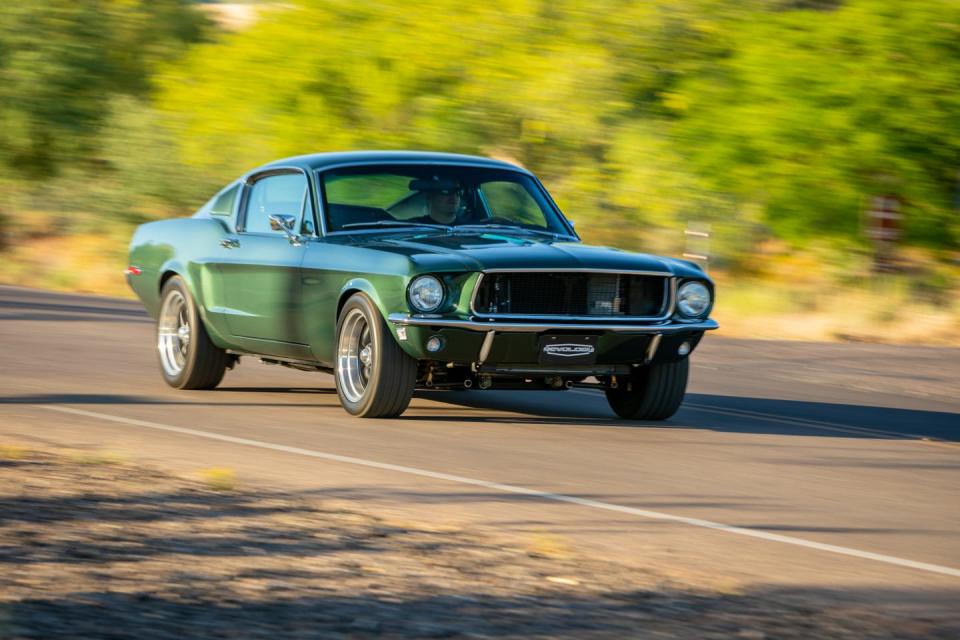Revology Mustang Shows 1968 Was Never This Good

Revology recreates Ford Mustangs of the late ’60s with modern technology, but they cost nearly $300,000. Which begs the question, “Is it worth it?”
The “1968” Revology Mustang we drove had almost nothing left from the original car but did have a modern engineering in a body that looked original.
Company founder Tom Scarpello says, “Don’t call it a restomod!”
Revology can’t take you all the way back to your high school youth and make you catch that winning touchdown pass that you dropped, but it can give you the Mustang you wish you had.
The Orlando-based Mustang specialist is surely the most meticulous restorer of original Ford pony cars of any company on the planet. I just spent 48 hours driving a manual Revology 1968 Mustang GT 2+2 Fastback and had a generally enjoyable experience, made all the more so as I mastered the art of driving a pseudo-original mid-’60s muscle car.
It has everything you would put on such a car if you had the engineering acumen and good sense to do it yourself. Under the hood is a 460-hp, 420 lb-ft 5.0-liter Ti-VCT DOHC V8 engine, the same basic powerplant you’ll find in a modern-day Ford Mustang Dark Horse. It’s mated to a T-56XL six-speed manual connected to a durable and quiet Ford 8.8 differential.

Of course, there is no traction control, no ABS, no stability control except that which you provide by keeping your right foot in check and keeping you from oversteering your beautiful Stang into the weeds. But the feel of the car through the skinny wooden steering wheel and from the too-high seat is of something better screwed together than anything Ford would have made in 1968, but not as well-screwed-together as what Ford is spitting out the doors in Flat Rock right now.
It’s a conundrum: buy a new Mustang Dark Horse for around $60,000, or buy a Revology Mustang based on the ghost of a 1968 fastback for five times as much?
You certainly get more looks with the Revology car, more thumbs-up, too, and more Mustang enthusiasts coming up to you and asking how long it took to build this project and what year it is and all kinds of things about this exciting retro dream machine.
And it is exciting. You get into it and you realize ergonomics weren’t what they are now way back in ’68. But the panel gaps are much better than they were then. The door closes with the same solid thunk, but then you have to hold down the “unlock” button on the key fob, step on the brake, and twist a knob up under the dash just to release the parking brake. Then you hold the key fob again, push in the clutch and the brake, and push the starter button.
All is forgiven when the mighty V8 ker-braps to life, irking the neighbors and scaring any cats who might have been napping within a two-block radius. Crack it into gear and release the too-heavy clutch pedal until the friction plates meet way up at the top of pedal travel, giving it just the right amount of throttle and—braaaam!—you’re roaring off down the street like it’s 1968 all over again except that everything is great this time.
The processes required to drive a modernized take on what used to be a 56-year-old car takes a little getting used. Like any new driving experience, your brain figures out how much throttle, at what rate, and where to engage the clutch, and pretty soon you’ve sorted it out. Light up the tires if you want, or even slide around a corner if you feel like it. Drift!
The interior is way nicer than whatever Ford was making in 1968. There’s full Nappa leather right down to the padded door inserts, and a nice wood veneer across the dash and center console. The aftermarket stereo, like many aftermarket stereos, has no knobs, and the spaces on the faceplate where you’re supposed to push to make things happen are too vaguely identified and a little frustrating.
The three-point seat belts are a nice touch that I don’t remember being around 56 years ago, even if you wonder about the security of the topmost mounting point up there on the roof rail.
Outside, the Borla exhaust pleasantly burbles while the Michelin Pilot Sport 4S tires on American Racing mags squeal exactly as much as you want them to squeal going around corners. It’s impressive how little body roll there is in this car, especially compared to Mustangs and musclecars of the 1960s. Likewise, the car doesn’t pull to one side when you apply the new Wilwood disc brakes.
If there are negatives, it’s the cost. The car I drove stickered at $294,775, enough to buy a new Ferrari. But as company founder Tom Scarpello said, “I have one customer in Florida who has 20 Ferraris and one of these. ‘When I drive one of the Ferraris,’ he says, ‘I’m just another @$$!* in a Ferrari, but in this thing, everybody enjoys seeing it.”
Yes, you could buy almost six Dark Horses for that price. Or almost 10 of the entry-level Mustang. Or four new Porsche 718 Caymans. Or four Corvette Sting Rays. The vast majority of Ford Mustangs from 1967 to 1968 sold on BaT go for under $50,000. There’s no logical reason you should buy one of these at this price. And yet you’re thinking about it, aren’t you? Go ahead, do it!

 Yahoo Autos
Yahoo Autos 